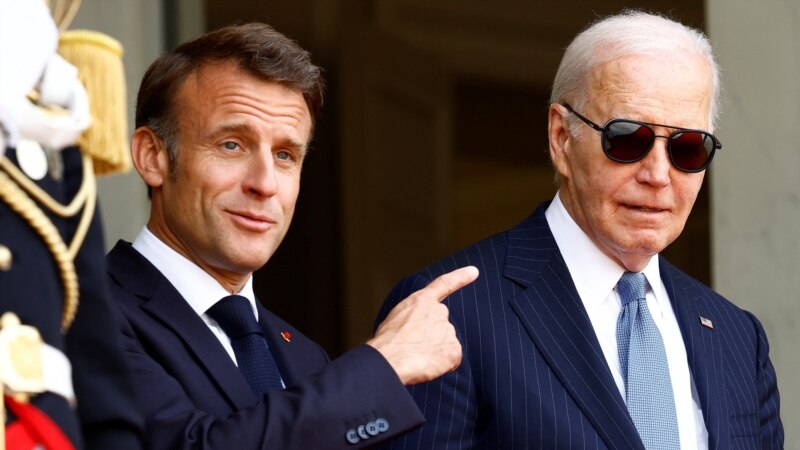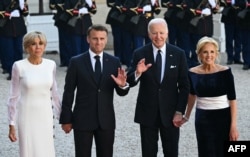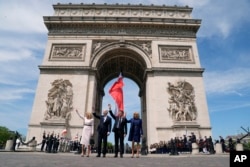This website uses cookies so that we can provide you with the best user experience possible. Cookie information is stored in your browser and performs functions such as recognising you when you return to our website and helping our team to understand which sections of the website you find most interesting and useful.
 PARIS —
PARIS —
U.S. President Joe Biden capped his visit to France by being feted with a tres-chic state visit Saturday — finishing with a flourish a trip that launches a frantic six-week diplomatic push that analysts say could radically alter Europe’s security architecture, right as the continent holds parliamentary elections that could shift the politics sharply inward at a time when Biden is stressing the need for global unity.
Leonie Allard, a visiting fellow at the Atlantic Council's Europe Center and a former French defense official, told VOA, “I believe that we are in a very significant sequence, not only for Ukraine, but really the future of European security, the future of the European architecture. With the NATO Summit coming, with the G7 summit coming, with European elections, U.S. elections — it's definitely a turning point for the future of the architecture in Europe.”
Complicating things further: In the coming days, hundreds of millions of European voters will elect members of the 720-strong European parliament. If voters choose right-leaning representatives, analysts say, it could shift the continent inward at a critical time.
“I mean, you’ll have a lot of far-right members that will complicate things, but they may not necessarily be united,” said Matthias Matthijs, a senior fellow for Europe at the Council on Foreign Relations, or CFR. “So, in that sense ... there’s going to be a lot of navel-gazing in both the EU and in the U.S. rather than focusing on the rest of the world.”
And, said Charles Kupchan, a senior fellow at CFR and professor of international affairs at Georgetown School of Foreign Service, Europe’s faith in Washington is also at risk.
“Even if Biden were to win Americans — Europeans are asking difficult questions about American reliability, and we did have a seven-month pause in the flow of aid to Ukraine even with an Atlanticist and a multilateralist in the Oval Office, and now we’re in a situation in which the likely next president, the leader in the polls, is a convicted felon, and that now is getting, you know, a lot of play in Europe and causing a lot of Europeans to scratch their heads,” he said.
French President Emmanuel Macron, who addressed Biden as “cher Joe” — “dear Joe” — said the leaders indeed discussed the need for unity on Ukraine and the impact of U.S. support, and the importance of the upcoming international summits. Overall, the two leaders trod over their areas of agreement, leaving aside any topics where they may not entirely see eye to eye.
“Thank you for being at Europe’s side,” Macron said.
He also addressed the divisive conflict in Gaza, speaking in support of the U.S.-backed cease-fire plan that Hamas and Israel have rejected and urging the militant group to release all hostages taken during their October 7 assault on Israel.
But now: Fashion
In this visit to a nation that prides itself as the beating heart of global fashion trends, both couples leaned heavily on couture to underscore their unity.
That was clear when the Bidens arrived at the sun-splashed Palace Elysee on Saturday for a state visit — he in a soft-shouldered navy pinstriped suit and jacquard tie the color of a stormy sky, and Jill Biden in a midi-length dress of a soft rose shade tied with a high black sash under the ribcage. Her pointy-toed black and white slingbacks and quilted boxy handbag were a nod to one of France’s best-loved fashion houses, Christian Dior.
And she topped off the ensemble with a crystal-laden Georgian-style collar necklace of the type often sported by the fashion editor who has been credited with radically reshaping the sartorial archetype of powerful American women, Vogue editor Anna Wintour.
The Macrons skewed darker, both in blue as well — he was in a deep suit a few shades short of black with a matching tie, she in a knee-grazing bright cobalt dress with a matching coat and pointy-toed stiletto pumps.
And for dinner, the presidents stuck to deep blue suits. The first ladies both wore straight-line, floor-grazing gowns. Macron wore an all-white shift – a color the French first lady often reaches for, including at the 2022 state dinner held for the Macrons at the White House. Her gown, with a high neck and long tulle sleeves, also featured chunky silver buttons down the left side. Biden chose a deep blue velvet off-the-shoulder gown with a wide, dramatic white sash that tied in a bow in the back and trailed behind her.
At dinner, both men delivered effusive toasts.
“We are allies and allies we shall remain,” Macron said, followed immediately by Biden, who described his visit to France as “the most remarkable trip I’ve ever made.”
“France and the United States have always been there for one another,” Biden said. “We stand together to defend the very values that are the soul of our two nations.”
Those choices, fashion experts say, speak volumes when leaders are often reluctant to speak about their differences publicly – especially at these types of visually impactful events. And these are noticed in France, where the presidential palace sits on a tiny street in central Paris lined with some of the nation’s top fashion houses like Chanel, Givenchy, Hermes and St. Laurent.
VOA floated a theory to Rachel Tashjian, fashion writer at The Washington Post: That the American president’s mood can be gauged by the blueness of his suit, which can vary from deep and dark at formal events, to almost ultramarine for more lighthearted occasions. Indeed, Biden wore blue of varying hues throughout his visit to France, including, for the somber and emotional commemorations of the 80th anniversary of D-Day, a deep navy suit.
“That’s an interesting theory,” Tashjian replied. “I think it's a color that he feels confident in. … And I think for him it also sort of promotes an image of stability, probably, you know, we're seeing him looking the same all of the time. And the stability is something that seems very important and central to his messaging.”
As for the first lady, Tashjian said, “I look at a lot of the dresses that she wears, which are very often floral dresses in pretty conservative or classic silhouettes or cuts. And you feel like you understand what she's trying to say ... ‘I am relatable, I'm a force of joy and happiness.’ ... You can also see, I think, her background as an educator. Very often she reminds me, her clothing choices remind me of things that my teachers wore when I was growing up. And I do think that that is a big part of what she does, and again, there's a sense of utility even when she's wearing high heels.”



 Africana55 Radio
Africana55 Radio 


